
800019-Rev 0
Wall and Base Cabinet Installation Instructions
CAUTION: Never use nails to mount cabinets. The use of nails may void your factory warranty, written or implied.
Before starting the installation
These instructions are intended as supplemental reference for those who have the appropriate skills and experience to safely and
successfully install cabinetry, including familiarity with basic carpentry principles and safe and proper tool use. Wall framing and construction
can vary greatly, and these instructions may not describe all construction methods. Also, there may be electric, plumbing, gas lines or other
utilities behind the wall, for which contact must be avoided during installation. If for any reason after reading these instructions you do not
feel condent in the ability to safely and successfully install this cabinetry, please contact a licensed contractor for installation. MasterBrand
Cabinets is not responsible for improper installation or property damage.
WARNING: Electric, plumbing, gas lines and other utilities, are frequently installed or embedded behind walls where cabinets are being installed. Before
drilling any holes or driving any screws, be sure you will not be making contact with any of these utilities. Failure to follow these instructions may result in
property damage and serious or fatal injury. If you do not feel condent in your ability to insure that you will not make contact with utilities behind a wall
during installation, please contact a licensed contractor to install the cabinets.
Step 1: Inspect New Cabinets
All cabinets are subjected to quality inspections before leaving the factory, and have been carefully packaged to prevent damage during
shipping and handling. Unfortunately, damage may occur occasionally in handling between the factory and the nal destination. Inspect
each cabinet carefully. If damage is discovered, place the cabinet back into the carton and notify retailer of purchase.
Step 2: Determine Cabinet Placement
Remove baseboard and other objects on the wall area where the cabinets are to be installed. Using a straight
edge and a level, nd the high point in the oor where the cabinets are to be installed. From the high point, mark
a level horizontal line on each wall where the cabinets will be attached. From the level lines, mark additional
parallel, level horizontal lines at 35" (or 34 1/2" if your product dictates) up and at 54" up for the top of base
cabinets and bottom of wall cabinets. These lines will be used for alignment when installing the cabinets.
Step 3: Prepare for Cabinet Installation
Locate the studs with a stud nder and mark where the cabinets are to be installed. Remove all the doors,
drawers and adjustable shelving from the cabinets before installation. This will reduce the weight and allow
easier access during installation. Measure the area to conrm that the kitchen design used will work.
Step 4: Begin Wall Cabinet Installation
Start installing the wall cabinets in the corner (if applicable). Place the wall cabinet at the predetermined
reference line. It is recommended to use a brace (example: t-brace) to help hold wall cabinets in place.
Measure from the corner to the rst wall stud mark. Transfer this measurement to the inside of the wall
corner cabinet. Mark the placement of the next wall stud. Drill through the wall cabinet back into the
prelocated wall studs with a
3
∕
32
" diameter drill bit, approximately 2" deep. The holes should be positioned
2" down from the inside top of the cabinet but should come no closer than 2" to any inside vertical edge
of the cabinet. Cement, block, brick or tile walls will require anchors for screws or toggle bolts. These will
need to be purchased separately if needed. Insert the 2½" round washerhead screws into the holes
until they are nearly tight. Do not tighten the screws until all nal leveling and shimming is completed as
needed. Check the front, sides and bottoms of all wall cabinets with a level. After the cabinet is level and
plumb, tighten the installation screws.
Example of brace used to aid in installing
wall cabinets. Shown is a t-brace made of
scrap 2x4s and 1x4. Place a piece of scrap
carpeting over 1x4 to protect cabinet.
Use level to
draw line
Floor not
level
High point
Level
54″
35″
54″
35″
Stud marks
Tools Needed:
• Pencil
• Level
• Tape Measure
• Drill with
3
∕
32
” Bit
• Stud Finder
• Clamps
• Square
• Phillips Head Screwdriver
and drill driver bit
Materials Needed
• Wood Shims
• 2½” Trim Head or Flat Head Wood Screws
• 2" Trim Head or Flat Head Wood Screws and drill
driver bit (utilized for DC2430 ONLY)
• 2½” Round Washer Head Screws

800019-Rev 0
Step 5: Complete Wall Cabinet Installation
Continue the wall cabinet installation by placing the next cabinet on the wall at the predetermined reference,
using clamps to clamp the cabinet face frames together rmly. Be careful to line up the bottom horizontal
edges. With a
3
∕
32
" drill bit, drill starter holes through the face frames near the top and bottom. Insert and
tighten the screws. (Note: Utilize 2" trim head or at head wood screws if installing DC2430 cabinet). Check
cabinet with a level on the cabinet front, sides and bottom. Shim where necessary. Once the cabinet is level
and plumb, tighten all the installation screws and remove the clamps. Continue installing the rest of your wall
cabinets in the same manner.
NOTE: If installing a single wall cabinet, follow instructions shown in Step #9 for proper installation.
Step 6: Begin Base Cabinet Installation
Once the wall cabinets have been installed, the base cabinets can then be installed. Start installing
the base cabinets in the corner (if applicable). Using the clamps, align and join the cabinets together at
the face frames. Make sure that the face frames align both on the face and vertically. Follow Step 5 for
attaching face frames.
NOTE: For lazy susan cabinets, counter top supports must be added as shown.
Step 7: Level Base Cabinets
Check the cabinet, ensuring that it is level and plumb. Shim to ll uneven areas between the oor and
base of the cabinet, and between the wall and the back of the cabinet. Failure to do this step could
result in damage to the cabinet.
Drill through the cabinet back into prelocated wall studs with a
3
∕
32
" diameter drill bit, approximately 2"
deep. The hole should come no closer than 2" to any inside vertical edge of the cabinet.
Step 8: Complete Base Cabinet Installation
Insert the 2½” round washerhead screws into the holes until they are nearly tight. Make sure the back
is fully supported with shims as needed, and does not bow into any imperfections in the wall. Ensure
the cabinet is level and plumb and adjust as needed. Tighten the screws fully, and recheck to verify
that the cabinets are level and plumb.
Step 9: Install Single Wall Cabinets
Follow Steps 2 & 3 for preparing the wall for the single cabinet. The cabinet should be located on the
wall, so that the prelocated studs that will be used for attachment do not fall within 2" of the inside
vertical edges of the cabinet. Ensure that the cabinet is level and plumb and shim to ll uneven areas
between the wall and the back of the cabinet. Failure to do so could result in damage to the cabinet.
Pay close attention to the locations that the cabinet will attach to the wall, making sure that there are no
voids. Drill through the cabinet back or hanging rails, into prelocated stud(s) using a 3∕32" diameter bit,
2" deep in a minimum of 4 places. The holes should be no closer than 2" and no further than 12" from
any inside vertical edge. The holes should also be located at the top and bottom of the back. The use of
2½” round washer head screws is required. Cement, block, brick or tile walls will require anchors for the
screws. These will need to be purchased separately if needed.
Insert screws into the holes until they are nearly tight. Make sure that the cabinet back is fully supported
with shims as needed, and does not bow with any imperfections found in the wall. Conrm that the
cabinet is level and plumb, adjust as needed. Tighten the screws down and recheck that the cabinet is
level and plumb.
IMPORTANT: Structural modications of a wall cabinet can signicantly weaken the cabinet. For this reason modications are not recommended, such
as cutting the back to clear wall obstructions. If an obstruction exists, we suggest you rst try to use cabinet(s) that do not require modications. If
modication is required, the warranty of the cabinet is void and it is the responsibility of the installer to take appropriate steps to compensate for any
loss of strength or support due to the modication.
Shim
Shim
Shim
Shim
Shi
m
Shim
2” min.
12” max.
Shim
Shim
countertop
supports
countertop
supports
countertop
supports

800019-Rev 0
Step 10: Completing the Installation and Alignment
After cabinets are securely installed to the walls, reinstall all doors, drawers and adjustable shelving. Next, check each door and drawer for
proper alignment.
Example: If the drawer front does not lie ush against the face frame, check that the cabinet is level, both horizontally and vertically. It may
be necessary to realign the drawer guides as well. The drawer guides can be adjusted side to side by moving the slide member by hand
and making the necessary adjustments until the drawer lies ush against the face frame of the cabinet.
IMPORTANT: All doors and drawer fronts must be aligned prior to decorative hardware installation.
Cabinet Care and Maintenance
6-Way Hinge Adjustment
The hinges can be easily adjusted “up and down” by loosening the hinge screws attached to the face frame. Slide the door up or down until
aligned and tighten the screws. The hinges can also be adjusted “side to side” and “in and out”. See below
Trouble Shooting Guide: Problems You Can Handle
Even though your cabinets must pass rigid quality inspection procedures, irregularities arise as a result of shipping and handling procedures.
Also, certain errors during the installation process may cause problems that are not the fault of the cabinet manufacturer. Listed below are
several conditions and causes, as well as remedies for those situations.
Cabinet Cleaning: Interior
Cabinet interiors are surfaced with a urethane-coated laminate that resists scuffs, mars and most common household spills. Wipe with
a damp cloth or sponge. For food residue or grease, use warm water mixed with mild dishwashing liquid to wipe clean. 5% dishwashing
liquid to 95% water is a good ratio. Dry thoroughly. To avoid permanent damage, it is important to clean the spill and dry the surface
immediately.
Problem Possible Cause Solution
Cabinet doors do not align
vertically (up and down).
A hinge is twisted or the cabinet is out of
alignment or "racked."
Make sure the cabinet is plumb and level.
Adjust the door hinges.
Double Doors on a wall or base
cabinet do not line up.
This could be the result of improper cabinet
installation. The cabinet is out of alignment and
is not set level and square (plumb).
Loosen the cabinet from the wall and use
shims to properly square up the cabinet.
Adjust the door hinges.
Space between the two
adjoining doors is too great.
A hinge is out of adjustment. Adjust the door hinges.
Cabinet drawer does not
close evenly.
Drawer alignment is poor. Manually adjust the drawer guide member.
A. In & Out Adjustment
For bowed and warped doors.
(See illustrations below.)
B. Up & Down Adjustment
For misaligned doors. Loosen screws,
adjust, then re-tighten screws.
C. Side to Side Adjustment
For gaps between double doors.
Clockwise to adjust out, counter
clockwise to adjust in.
A A
B B
C C
D D
FULL OVERLAY PARTIAL OVERLAY

800019-Rev 0
Cabinet Cleaning: Exterior – Wood Cabinets
Wood exteriors are manufactured with a quality nish that protects the wood. Monthly cleaning is recommended. Wipe the surface of the
cabinets with a clean damp cloth, and dry with another clean cloth. For general soil or grease, use warm water mixed with mild dishwashing
liquid to wipe clean. 5% dishwashing liquid to 95% water is a good ratio. Dry thoroughly. Excess moisture can damage any cabinet nish;
areas near the sink, range, dishwasher, oven and baseboards are the most susceptible and must be kept dry. Waxing is not recommended
and over time, waxing and polishing compounds may build up on cabinet surfaces forming a hazy, streaked or yellowed appearance.
Cabinet Cleaning: Exterior – Laminate
Laminate cabinets are surfaced with a durable PVC that is colored throughout, allowing for years of outstanding wear and beauty. Monthly
cleaning is recommended, using the same procedure described for wood exteriors.
CAUTION:
Avoid using cleaners that contain bleach, ammonia, citrus based products or any type of abrasives (see cleaner label). These cleaners can cause damage to
the cabinet nish.
Characteristics of Wood
Authentic woods vary in color and character markings such as streaks, knots and grain patterns. Since the nish stains may attract differently to these
grain patterns, some light and dark areas may result. The beauty lies in these natural variations of color and grain that give each cabinet its own individual
charm. Over time, changes in the nish color may occur. Because of a natural aging process, the nish can also “deepen” over time, darkening the color of
the wood or creating a “shadowing” effect where doors overlap the frame. Due to these minor differences in tone, it may not be possible to match the nish
color of existing cabinets exactly when replacing doors or adding cabinets at a later date. Lighter & natural nishes and glazes highlight the inherent qualities
of genuine wood to create a truly beautiful product. Only select solid hardwoods and hardwood veneers have been used to construct your cabinetry. The
beauty of these genuine woods lies in the variations of color and grain. Shadings of white, red, black, yellow and even green may be visible. Mineral streaks
may also add to the distinctive appearance, reecting the tree’s “life history” as it absorbs minerals differently from one area to another. Grain and apparent
texture may range from even and consistent to varied and dramatic. These natural variations result in unique character markings on adjacent cabinets, on
pairs of doors and even within the same panel. These variations can also appear on edges of hardwood doors where solid lumber cores are exposed in
certain styles. These unique characteristics of wood are pointed out to remind you that each piece is different. The varied affect, more clearly evident in the
natural nish, may be different in a complete kitchen from that represented by a smaller display or nish sample. Neither we the manufacturer, nor your dealer
can be responsible for the type or degree of variations which may actually characterize your cabinetry.
Characteristics of Laminate
Laminate cabinetry features doors and drawer fronts surfaced with Laminate PVC. These products also feature face frames constructed of solid wood with
a painted nish protected with a catalyzed varnish. Woods naturally expand and contract with changes in temperature and humidity; therefore, some visible
cracks may eventually form in the area of cabinet joints. Since the doors and drawer fronts are fabricated with different materials than the solid wood face
frames, the natural aging process may cause the two materials to show some color variations. The levels of exposure to sunlight, smoke and household
chemicals will all have an impact on the color variation.
The preceding is not a warranty. If you have specic warranty questions, contact the manufacturer’s customer service for warranty information and limitations.
-
 1
1
-
 2
2
-
 3
3
-
 4
4
Ask a question and I''ll find the answer in the document
Finding information in a document is now easier with AI
Related papers
-
Diamond NOW 28 U18R Installation guide
-
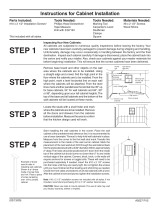 Diamond NOW W3030 Installation guide
Diamond NOW W3030 Installation guide
-
Diamond NOW F12DC2436R Operating instructions
-
Diamond NOW SLCDO.GRES.MP.STM User manual
-
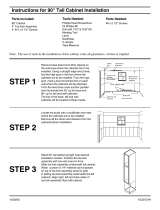 Diamond NOW 36 U18R Installation guide
Diamond NOW 36 U18R Installation guide
-
Diamond NOW 36E B21R User manual
-
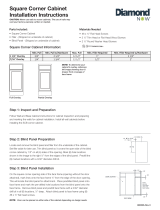 Diamond NOW 36E SCB36R Installation guide
Diamond NOW 36E SCB36R Installation guide
-
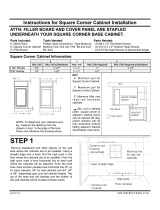 Diamond NOW G15 SCB36R Installation guide
Diamond NOW G15 SCB36R Installation guide
Other documents
-
AccuCold ALF620IF User manual
-
Unbranded HDC-027A (1) User guide
-
J COLLECTION DSB30FH-BR User manual
-
Home Decorators Collection EN1201-CTW Operating instructions
-
FlowerHouse FHXUPT-GT Installation guide
-
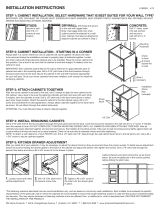 Hampton Bay KAFS330-CHR Installation guide
Hampton Bay KAFS330-CHR Installation guide
-
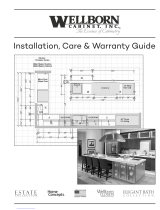 Wellborn Cabinet Estate Series Installation And Care Manual
Wellborn Cabinet Estate Series Installation And Care Manual
-
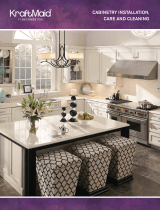 KraftMaid VC4821L6S7.RBE.7118PN Installation guide
KraftMaid VC4821L6S7.RBE.7118PN Installation guide
-
 American Woodmark VSDB3634HL W/ TPL4.3213SN.TOP3822QUASR Installation guide
American Woodmark VSDB3634HL W/ TPL4.3213SN.TOP3822QUASR Installation guide
-
Premier ANE-42 Installation guide











